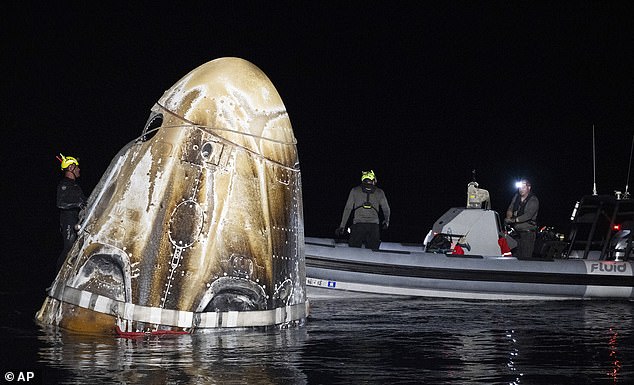A NASA astronaut gave a cryptic explanation about why their four-person crew was mysteriously hospitalized after returning to Earth from space last month.
Astronauts Matthew Dominick, Michael Barratt and Jeanette Epps were taken to a medical facility in Florida after splashing down on October 25, with one of the crew staying overnight for ‘observation.’
Russian cosmonaut, Alexander Grebenkin, returned with the NASA crew and was also taken to the hospital in nearby Pensacola, but did not speak at a live briefing Friday.
NASA has been tight-lipped about the reason for the hospital visit and the crew continued to dodge questions at the briefing Friday.
‘Spaceflight is still something we don’t fully understand,’ Barratt said.
‘We’re finding things that we don’t expect sometimes. This was one of those times and we’re still piecing things together on this.’
The trained medical doctor only referred to the emergency room visit as a ‘medical event,’ saying that NASA will reveal all details ‘in the fullness of time.’
While NASA has refused to provide any other information, an insider told DailyMail.com that ‘blood pressure issues’ could have landed them in the Florida hospital.

Astronauts Matthew Dominick, Michael Barratt and Jeanette Epps, along with Roscosmos cosmonaut Alexander Grebenkin were hospitalized upon returning to Earth from the ISS
The NASA astronauts continued to touch on the ‘medical event,’ but shying away from details about which one of them stayed overnight.
‘Everyone’s different,’ Epps said, ‘and that’s the part you can’t predict.’
Dominick, however, noted: ‘The big things you expect, being disoriented, being dizzy.
‘But the little things, like just sitting in a hard chair, my backside has not really sat in a hard thing for 235 days… It’s rather uncomfortable, right? I did not expect that.’
Astronauts returning to Earth experience a dramatic drop in blood pressure, which can lead to orthostatic hypotension, a form of low blood pressure that happens when a person stands up or lies down.
Orthostatic hypotension happens in astronauts because gravity pulls blood downward when their bodies have been in low gravity, thus causing a shock-like impact on their system.
Symptoms of orthostatic hypotension include lightheadedness or dizziness and occurs in nearly all astronauts after long-term missions.
While the source told DailyMail.com that this could have been the cause of the hospitalizations, they said: ‘NASA can play the ‘medical privacy issue’ all day long.’

The Crew-8 astronauts splashed down on the SpaceX Dragon Endeavor on October 25, following a 235-day mission. NASA
The crew was stranded on the ISS for eight months when their stay was scheduled until early August, but Boeing’s faulty crew capsule and Hurricane Milton made the summer return impossible – clocking in a total of 235 days.
Crew-8 successfully splashed down at 3.30am ET, following the launch to the orbiting laboratory on March 3.
During a meeting of the Aerospace Safety Advisory Panel on October 31, former astronaut and committee member Kent Rominger listed a series of ‘recent issues’ with SpaceX’s Falcon 9 rocket and Dragon spacecraft.
He said the mishaps serve as a reminder to remain vigilant as the company increases the pace of its missions.
‘Both NASA and SpaceX need to maintain focus on safe Crew Dragon operations and not take any ‘normal’ operations for granted,’ Rominger said.
The American space agency had only noted that one crew member was taken to the hospital, but it was later found that all four had made the trip.
NASA’s decision not to disclose who that astronaut was or reveal details about his or her condition was made ‘to protect the crew member’s medical privacy.’
But insiders have speculated low blood pressure was the cause.
‘On return to Earth, gravity once again ‘pulls’ the blood and fluids into the abdomen and legs,’ according to NASA.
‘The loss of blood volume, combined with atrophy of the heart and blood vessels that can occur in space, reduces the ability to regulate a drop in blood pressure that happens when we stand on Earth.’











